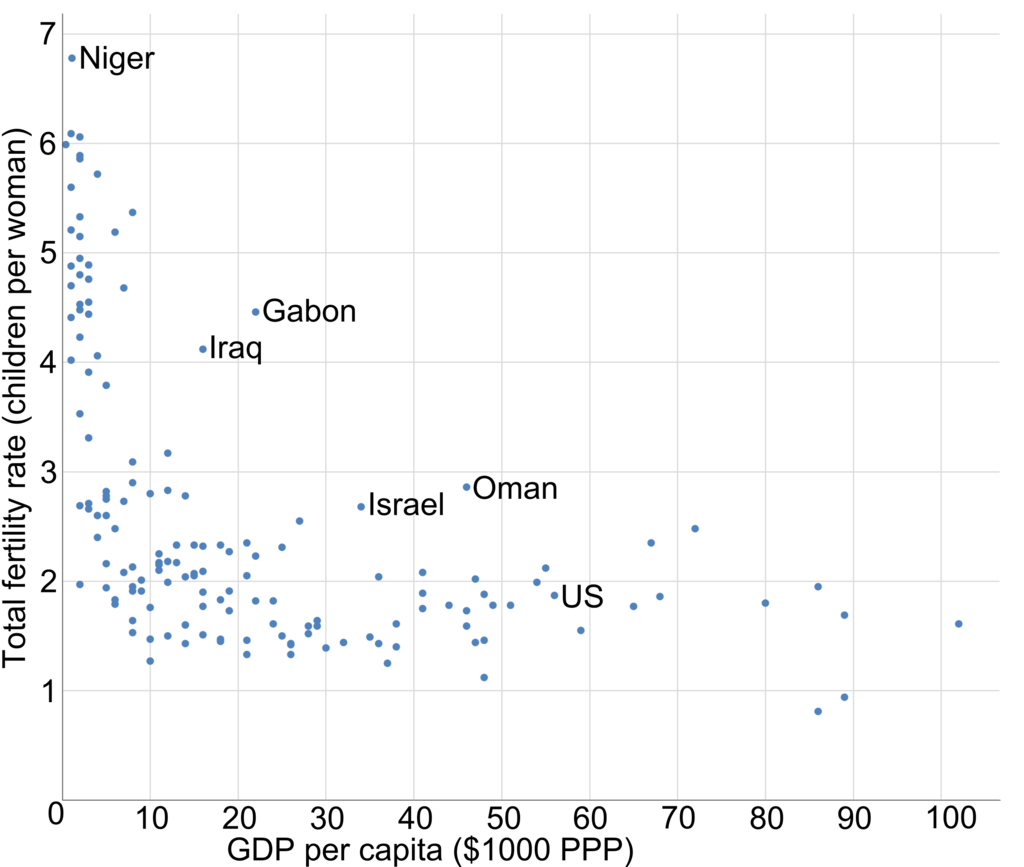Macro Minute: The Fertility Crisis: Why Economic Decline, Not Technology, Will Boost Birth Rates
Exploring the link between wealth, fertility, and technological progress—and why a global economic regression may be the only path to reversing declining birth rates.

The Bitcoin space is starting to pay attention to demographics. Of course, I've been speaking about this disaster for years now. I believe it is the issue of the next 50 years and will dictate the future of the monetary system.

I cannot provide this important Bitcoin and Macro analysis without you.
Bitcoin & Markets is enabled by readers like you!
A Natural Rebound in Fertility
I ran across this tweet from Nic Carter yesterday morning on X. It seems that he is new to this issue and has yet to form a sound position. I hope he continues to explore this topic and not entrench in his early opinions.
the thing that annoys me about birth rate discourse is the extrapolation of present low birth rates to the distant future. birth rates have been changing (declining) and yet the doomers simply fix today's low rates and assume they will be static forever from this point on.…
— nic carter (@nic__carter) October 3, 2024
Nic approaches the issue from a naturalist perspective, which is the right general approach in my opinion, but it's directionally wrong. His biological argument is that current low levels of resource availability is causing low birth rates. As global populations shrink, resources will be freed up and birth rates will naturally rebound. He claims that population shrinkage will ease economic pressures like housing costs, commutes, and childcare expenses, allowing families to feel more capable to provide for children. He also falls back on a belief that automation and AI will increase resource abundance, further supporting higher birth rates in the future.
Wealth And Fertility Are Inversely Correlated
In response, I argue that while Nic's position feels intuitive, the reality of declining fertility rates is actually counterintuitive.
It's well established that fertility is *inversely* correlated with income levels. Countries cross replacement fertility at ~$10K per cap.
— Ansel Lindner (@AnselLindner) October 3, 2024
Regarding biology, we’ve fundamentally altered the natural processes you’re describing. The feedback loop you're suggesting may no longer… pic.twitter.com/MrBFtIm3bo
First, it's well-documented that fertility rates are inversely correlated with rising income and resource availability (except at the very highest income levels of $1M/year or more). In the chart below, you can see that fertility falls with income until it stabilizes at around $500k/year. Even those earning over $1M barely exceed the replacement rate, and this group is, of course, much smaller in number. This is important because even those at extreme levels of wealth are barely over the replacement rate. Therefore, counter to Nic's argument, as available resources increase for the vast majority of any population, fertility declines.

According to Nic's view, the above curve should rise as income increases, but it simply does not. We see the same pattern below when comparing rich to poor countries. The higher the per capita GDP, the lower the fertility rate. You can see a best fit line would cross below replacement rate at roughly $10,000 per capita.

Economics Of Fertility
Nic's main economic assumption is, "lower population reduces competition for these resources," implying their cost will fall. He does notice the limitation on this rationale by adding, "Obviously this is a simplified model, it could be the case that lower demand also raises costs. For instance, if there's very few kids running around, childcare could become more expensive because daycare centers can't reach the scale to justify fixed costs."
As the working-age and consumption-age population declines, it will lead to economic contraction, not growth. An individual will have a larger piece of a shrinking pie, and a pie that is losing complexity and ingredients. Fewer workers will lead to fewer specialties and labor force complexity.
Nic's whole fertility argument starts with incomes/resource availability being relatively low, causing fertility decline. The fertility decline then leads to population decline and freeing up of more resources per capita. However, we've shown that this assumption is incorrect—lower fertility rates are actually associated with higher income and resource availability.
Raising income/resource availability leads to further fertility decline, not a bounce back. This is the counterintuitive part, humans must decrease their living standards and income to boost fertility naturally. The question becomes: are we prepared for incomes to drop below $10k per capita along with associated living standards?
Technological Advancement Coincides With Fertility Decline
Another common fallacy in the demographics debate is the belief that technology will save us. This is an appeal to progress, and we’ve already shown that economic progress correlates with lower fertility. Unsurprisingly, technological advancement is also closely linked to fertility decline.
Again, this is counterintuitive. If we push for technology to solve our fertility problem, the data shows we will likely make the problem worse.
Technological progress in a shrinking economy and unwinding the complexity of that economy is far from a given. I recently heard Samo Burja, political scientist and creator of The Great Founder Theory, say on a podcast that we might have already passed peak technological development, since in the future we will have fewer scientists, fewer inventors, and fewer entrepreneurs and knowledge has a way of decaying through time.
In a period of declining economic growth, technological development will be difficult, not only to for the reason stated above, but also because there is a smaller addressable market to serve and support, making AI and automation less profitable.
The Likely Outcome: A Natural Regression
We’ve discussed how rising standards of living and resource availability have contributed to the fertility crisis, and how this crisis will lead to less economic activity. The next obvious question in a self-balancing system is: How far does economic activity have to fall before fertility rates rise again?
For example, Nic assumes population decline will free up housing supply, lowering the cost. That would be nice, but he's arguing from a faulty premise. Instead of asking how things will improve to stimulate fertility, we must ask how bad things have to get to stimulate fertility.
We should be thinking about the fallout from housing affordability getting worse. To "fix" fertility, housing and living standards in general will have to deteriorate much further.
What I’m suggesting is that humanity may need to dismantle the modern economy and reduce resource availability in order to increase fertility rates. Economic decline will continue until the technologies and cultural practices that emerged during the post-industrial time of abundance become too costly to maintain.
Places Of Refuge
This is a harsh realization, but there are things you can consider to place yourself and your family in a better situation. You will be able to benefit relative to others who are unaware of this issue.
The negative consequences of the fertility crisis will not be evenly distributed. Some countries already have rapidly falling populations, while others are still decades away.
Emigration will become as big a topic as immigration. For East Asian and European countries in particular, as their economies and societies break down, the top performers—say, the top 1%—will emigrate. This will accelerate the problems in those nations and bolster the destination countries' economies. Since the U.S. is 20 years behind other countries in the fertility crisis, it will be attractive for these overachievers to emigrate to the U.S.
Holistic economies will also fair better. A country that can grow its own food, provide its own energy, have access to relatively more securable natural resources, will be better off.
Older populations will demand different services than younger, consumption-driven demographics, providing forward-looking business opportunities.
In the end, the fertility crisis is not something that technological progress can solve, and it may even exacerbate the issue. Declining populations will lead to reduced economic complexity, fewer innovations, and a reversal of the trends that once supported modern societies. As we move forward, the most realistic path to higher fertility rates might come from an economic regression that lowers living standards to the point where large families once again become a viable option.
Hope this helps someone.
Your support is crucial in helping us grow and spread my unique message. Please consider donating via Strike or Cash App or becoming a member today and get more critical insights!
Follow me on X @AnselLindner.
I cannot provide this important Bitcoin and Macro analysis without you.
Bitcoin & Markets is enabled by readers like you!
Hold strong and have a great day,
Ansel
- Were you forwarded this post? You can subscribe here.
- Please SHARE with others who might like it!
- Join our Telegram community
- Also available on Substack.
Disclaimer: The content of Bitcoin & Markets shall not be construed as tax, legal or financial advice. Do you own research.




